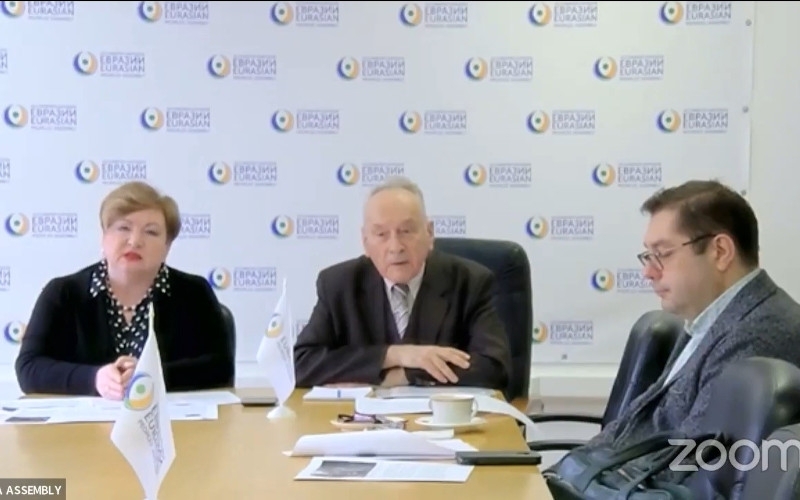
Photo: Svetlana Smirnova, Valery Ruzin, Vladimir Simindey
On February 19, 2022, the Eurasian Peoples’ Assembly will hold the 13th Session of the International Public Forum “Preserving the memory of World War II and the Great Patriotic War” – “Grateful descendants in memory of the exploits of the 130th Order of Suvorov Latvian Rifle Corps of the Red Army”.
Partners: Daugavpils Branch of the Russian Community of Latvia (Daugavpils, Latvia), Baltic Center for Historical and Socio-Political Research (Latvia), Libava Search Center (Liepaja, Latvia).
The goals of the forum are to draw attention to the issues of preserving the historical memory of peoples, supporting the movement against the erosion of value and semantic aspects of history, falsification of the results of World War II and the Great Patriotic War; preparation for the establishment of the Association of descendants of soldiers of the 130th Latvian Rifle Corps of the Red Army; activation and search for new practices for the formation of constructive images of the memory of the Victory over Nazism, which would help strengthen mutual understanding and peaceful relations between countries and peoples.
Moderators:
- Valery RUZIN, Deputy Secretary General of the Eurasian Peoples' Assembly, President of the Eurasian Academy of Television and Radio (Russia);
- Yurijus TRAKSHELIS, Deputy Secretary General of the Eurasian Peoples' Assembly, Chairman of the NGO "Institute of Military Heritage" (Lithuania).
The forum will be attended by historians, journalists, search teams, representatives of military and veteran organizations, public figures from five countries - Russia, Latvia, Lithuania, Estonia and Kazakhstan.
The First Deputy Secretary General - Head of the General Secretariat of the Eurasian Peoples' Assembly Svetlana SMIRNOVA delivered a welcoming speech:
- Good afternoon, dear colleagues, dear friends! I'm glad to see familiar faces on the screen today. I welcome you on behalf of the International Union of Non-Governmental Organizations "Eurasian Peoples' Assembly" and our General Secretary Andrey BELYANINOV.
On the sidelines of the International Film Festival "WON TOGETHER" in Sevastopol, there was an idea and the first International Public Forum to preserve the historical memory of the Second World War and the Great Patriotic War was held. Today we are having the 13th forum. Even the number of forums held suggests that this topic is very relevant and interesting for both participants and viewers of our broadcasts.
The main task of our forums is to draw attention to the historical memory of the Second World War, the continuity of generations. It is important for us that young people know about the historical exploits of the Soviet people. It is very important that there be no attempts to blur the value and semantic aspects of history, falsification of the results of the Second World War and the Great Patriotic War. Unfortunately, this happens in many countries, so the task as of state authorities, so as ours - public organizations - is to do everything possible so that the memory of our great historical dates, the great deeds of the Soviet people is passed on to the younger generation.
That is why the Eurasian Peoples' Assembly promotes the idea of establishing associations of liberators’ descendants. We already have a fully realized example - this is the International Association of Panfilov's descendants and their friends, which is led by the professor of Al-Farabi Kazakh National University Layla AKHMETOVA. This is a very important activity area- it is important that the descendants of the liberators and their friends know and popularize historical memory today.
The war affected the lives of hundreds of millions of people living in different countries and on different continents. Today, the truth about it is important for each of us - the winners’ descendants, the descendants of the heroes who stopped Nazism.
We want the associations of the descendants of the winners of various military formations to become an international movement in every country, in every region, so that we gather children and grandchildren in memory of that Great War.
Today we see great genuine interest in these issues not only from the public in Russia as the successor to the USSR, but also from the public of many other countries. Members of the Eurasian Peoples' Assembly are representatives of non-governmental organizations from more than 50 countries of Greater Eurasia; more than 140 agreements have been signed with partners from different countries. The establishment of an association of descendants of soldiers-liberators, the creation of an international register of monuments to the soldiers of the anti-Hitler coalition, the development of public and state awards for contribution to the Victory should become a daily affair for each of us throughout the Eurasian space.
The current international situation suggests that the issues of war and peace are very acute. We need to do everything possible so that you and I no longer use the word "war", but talk more about peace. This is our common task - to make our world kinder, brighter. I wish all the participants of today's forum fruitful work in the name of a peaceful future for planet Earth.”
The Executive Secretary of the International Union "Combat Brotherhood" Gennady SHOROKHOV, a retired colonel, a veteran of military operations in Afghanistan (Russia), took part in the forum for the first time:
“We plan to speak about the truth in the broadest sense of the word. This is the main thing today. In European countries, especially in Latvia, today, unfortunately, they do not like historical truth.”
Janis KASPARSONS the participants of the Great Patriotic War, head of the Association of Soldiers of the 130 LRC and fighters of partisan brigades (Latvia) welcomed the participants.
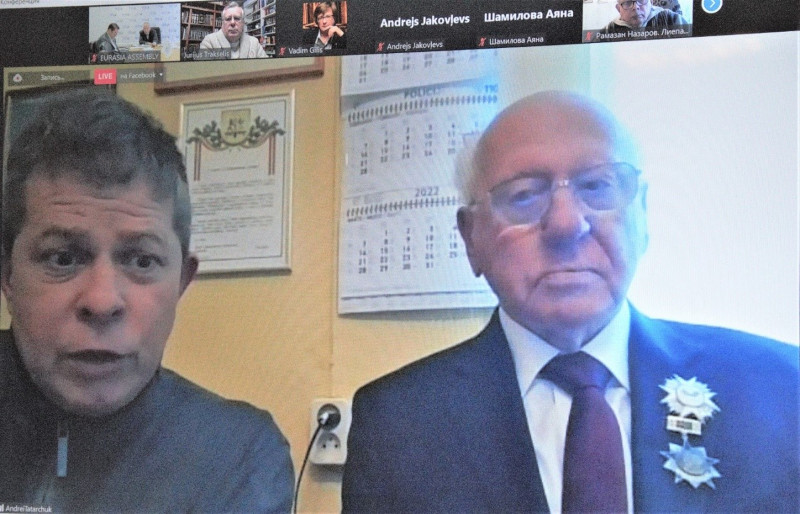
Photo: Andrey Tatarchuk and Janis Kasparsons
He noted that the 43rd Guards Latvian Rifle Division bore the brunt of the war in Latvia. Time takes its toll; there are few combat veterans left: 13 shooters and 7 partisans out of 3,500 people in 1995.
Consul General of Russia in Daugavpils Evgeny KOLESNIKOV told in detail how many new tasks grow out of one task in search work.
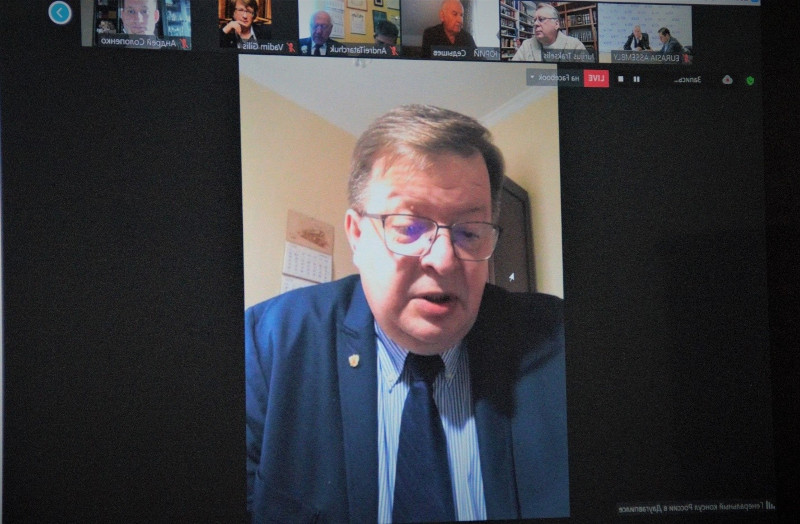
Photo: Evgeny Kolesnikov
- Today I would like to talk about the preservation of the memory of the Great Patriotic War in the territory of Latvia as a combination of military memorial and search work. We are more engaged in what is connected specifically with military memorial work. The search aspect, as a rule, remains outside the brackets. We do not go beyond our competence, but expand the scope of our activities by joining our efforts with people and organizations that share our interests.
War memorial work is an important part of the activities of Russian missions abroad, through which the Great Patriotic War swept. There are more than 360 graves of Soviet soldiers in Latvia, which are cared for in accordance with the intergovernmental agreement “On the status of military graves in the territory of the Republic of Latvia and Latvian graves in the territory of the Russian Federation” dated December 18, 2007. War memorial work is often understood primarily as the care of graves.
But it is also necessary to deal with search and / or research activities, which formally go beyond the competence of the embassies of the consulates general, in order to preserve the memory of the Great Patriotic War and the people who gave their lives defending their homeland from fascist invaders.
A year and a half ago, the Consulate General received an appeal sent to us through the Ministry of Defense of the Russian Federation by the descendants of the sergeant of the 41st Tank Red Banner Brigade of the 2nd Baltic Front Alexander Maksimovich Loskutnikov, who, according to documents recently published on the website "Memory of the People" about the losses of the USSR in the Second World War, died on June 28, 1944 near the village of Malinovka, Daugavpils district of the Latvian SSR, and was, as indicated in the report on the losses of his unit, buried there. Since the name of Loskutnikov does not appear in the lists of any of the burials located in this area, the relatives asked to tell where exactly the remains of their ancestor were buried, or to submit a proposal on which of the fraternal military graves his name could be perpetuated. Even a superficial study of archival documents available in the public domain led us to a number of interesting conclusions that are important from the point of view of finding answers to the questions posed. First of all, it was established that Sergeant Loskutnikov was the gunner-radio operator of the tank crew of the T-34 tank of the 3rd tank battalion of the 41st tank brigade, which suffered serious losses during the tank battle in Malinovka on July 22, 1944.
This episode, as it turned out, was described in the memoirs of the German tanker Otto Carius translated into Russian, and subsequently the BBC created a documentary on it describing that battle according to the version, of course, of the German tanker, who positioned himself as a tank ace. Looking ahead, I note that the German distorted a lot in his memoirs, if not misrepresented, however, some details of his memoirs helped us, in comparison with Soviet archival documents, to conclude that Sergeant Loskutnikov: a) was a member of the tank crew of the commander of the 3rd tank battalion of the 41st Tank Brigade of the Hero of the Soviet Union Captain Ivan Nikolaevich Moroz, later reburied in the park near the Eternal Flame in Dubrovino Park in Daugavpils; b) Loskutnikov died and was initially buried by the Germans together with Captain Moroz, and hence the date of death of both is July 28, when this burial was discovered by Soviet soldiers after the liberation of Malinovka. Although it is well known that the tank battle itself took place six days earlier, on July 22.
The second important conclusion from the study of Soviet documents was the conclusion that during the battles for Malinovka from July 22 to July 28, 1944, several dozen Soviet soldiers died, who were initially buried in several individual and several mass graves in the village itself and near it. At the same time, the names of several dead are immortalized at a fraternal military burial in the town of Skrudalino and partly in the town of Shpoge, a few kilometers from Malinovka. Meanwhile, at the local cemetery today there is only the burial place of a single tank officer from the 41st tank brigade. The resting place of 40 soldiers and officers, including Sergeant Loskutnikov, is still unknown.
Already at this stage, it became clear that in order to sort out this confusing situation, we would need the assistance of search teams. With the help of members of the “Memory” search detachment from Daugavpils, we managed to find maps of that battle, on which the places of the primary burial places of the dead were plotted, and it was also recorded where the Soviet tanks knocked out by the Germans stood. Several trips were made to the area in search of these places, and most importantly, contact was established with the modern residents of Malinovka.
In parallel, our employees went to the Daugavpils regional branch of the Latvian State Archives. The goal was clear. The primary burials of Soviet soldiers carried out in 1944 were subsequently moved to another place. The question is where? The search teams are well aware of the scale of this problem: the burial has been moved - where, it is not clear. And there are no documents, and where to look is unknown. More than once I had to deal with situations when on paper the burial was moved, but in reality - as a result of a symbolic reburial - it remained in place. It became clear that we needed evidence and witnesses. Archival activity, despite the significant investment of time, was crowned with partial success: protocols of collective farm meetings of the post-war period were discovered, in which it was about instructions issued from higher authorities on the harvesting of wood in order to make coffins for transferring the remains of Soviet soldiers from burials scattered around the village to one place in the village cemetery. A log of military graves in Malinovka and its environs as of 1945 was also found there. Unfortunately, there are no names there, but the number of those buried and the location of the graves were indicated.
Incredibly, there were also witnesses, including eyewitnesses to the events of 1944. It is clear that today they are already very many years old, and then they were at a very young age. But the military events in the village became part of the family history of the locals, which were repeatedly told to the children by their parents, and these parents were direct participants and eyewitnesses of the events of those years. So, one of the women, who was only seven years old in 1944, remembers well the tank battle, which partially took place almost in the courtyard of their house: “Grandma remembered well that after the war, the remains of Soviet soldiers were solemnly reburied in the village cemetery in 37 coffins.” Here we remembered that we were looking for 40 fighters who had disappeared. There was a reasonable assumption that later these burials could again be transferred to the memorial cemeteries in Daugavpils, where there really are graves of unknown soldiers.
Another local resident drew our attention to the burial, which her father carried out at the local cemetery in 1944, a couple of weeks before the liberation of the village by Soviet troops. According to her, secretly from the Nazis, they interred the body of a Soviet pilot, who was found in a field a hundred meters from their farm. The pilot's papers were seized and hidden under the cladding of the house. But the house itself burned down along with the documents during the fighting in July 1944. We actually found a grave of an unknown person in the village cemetery, which was not listed in the register of military graves in the territory of Latvia. We are currently coordinating with the authorities the installation of an appropriate tombstone. And taking into account the circumstances of the burial, which the witness told us, the search team put before the authorities the question of carrying out probing work in order to establish the identity of the deceased Soviet pilot. There is such an opportunity, and we will definitely try to use it.
In the course of the research, it turned out that fierce battles in Malinovka took place not only in 1944, but also in 1941. One of the divisions of the Red Army, retreating from Daugavpils, entrenched itself in Rezekne. Local residents said that the Germans first used mortars against the Soviet fighters, and then heavy artillery and aircraft, as a result of which Rezekne was simply wiped off the face of the earth. However, even after that, shots continued to be heard in the direction of the Nazis. After suppressing the resistance of the Soviet soldiers, the Germans did not allow the locals to approach the battlefield for several weeks. The killed soldiers remained unburied for a long time, and then they were hastily covered in the remaining craters and trenches. The very first trip of a search team to this place confirmed the above picture of the battle - the first remains were raised just a few meters from the farm located next to this place. A superficial study of documents indicates that several dozen more Soviet soldiers died in this place; they, apparently, were never buried and remain missing. Work in this area will continue.
Along the way, in one of the village cemeteries nearby, a burial place of local residents, who were part of a partisan detachment defeated by the Nazis in 1942, was found. This place had come to an abandoned form. We also intend to bring it into proper form.
The foregoing concerns only one local episode; there were hundreds in the territory of Latvia. Researches that began with one appeal, and then, like a snowball, for a year and a half, involved more and more episodes of the war that ended 76 years ago continue. At present, permission has been requested to conduct sounding work in the Malinovka area in order to establish the burial places of Soviet soldiers who died in 1944. In other words, you just need to make sure that the remains are actually transferred.
The question was raised about establishing the name of the Soviet pilot buried by local residents at the Malinovsky cemetery during the Nazi occupation. It is necessary to continue work in the archive in order to find confirmation of the reburial of the remains in Daugavpils. Today, we know more or less exactly the number of those reburied, and most importantly, when it could have been carried out, and this significantly narrows the search field.
Ultimately, we intend to perpetuate the name of Alexander Maksimovich Loskutnikov and 39 of his other colleagues who died heroically in the Malinovka region in July 1944, but whose names have not yet been immortalized. And then we will continue to work on establishing the names of the soldiers of the Red Army who died on the outskirts of Malinovka in 1941. In the course of search expeditions, we expect to discover, exhume and bury the remains of those who have remained lying there since the summer of 1941. The work is ongoing and will last for a very long time.
After Yevgeny Kolesnikov’s speech, Valery Ruzin noted that these “facts are material for artistic comprehension and for research by documentary filmmakers”.

Photo: Valery Ruzin
The topic of the report by Vlad BOGOV, Chairman of the Board of the Foundation for the Development of Culture in Latvia, was the Salaspils camp, which left many questions for posterity. There is still no reliable information on exactly how many people passed through it, including children. It is known that many minors were admitted after Nazi punitive operations on the territory of Russia, Belarus, and Latvia itself.
But very often, unreliable information began to get into the public domain. Large federal television channels take it, make stories about this camp. For some reason, there is information that 130 thousand people died in the camp. This information is inaccurate. The media even say that 130 thousand children died. Further along the chain - hearing all this informational nonsense from the Russian media, Latvian historians naturally begin to consider this not only nonsense, but also propaganda:
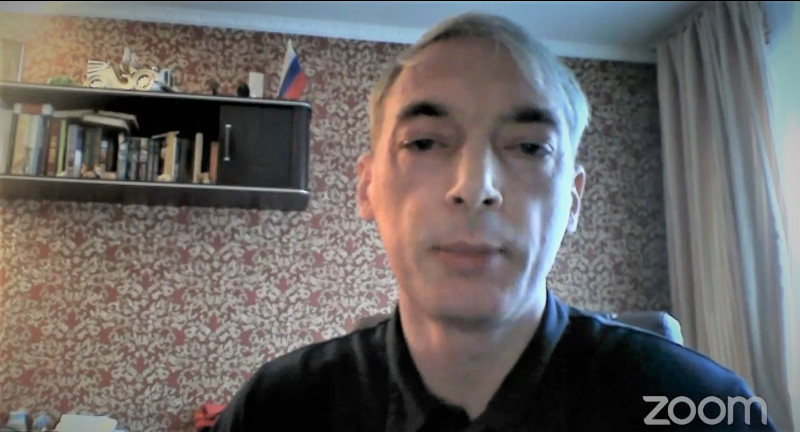
Photo: Vlad Bogov
“Therefore, I would like to give up-to-date information in some way. Salaspils is indeed a place of tragedy, where people were abused, where many children died. But far-fetched figures devalue the heroic deeds of people - local residents who saved these children. I present these facts in the book “Salaspils: Forgotten Names”. Sometimes people simply approached the barbed wire and, by hook or by crook, persuaded the guards to let them into the camp and take at least one or two children. We would like to push Russia to search for the truth in this matter.”
The book by Vlad Bogov summarizes the information known today: how the camp was formed, who was there, what were the conditions of detention. Greater emphasis is placed on photographic materials. The main motive for publishing the book was the need to publish a database of prisoners who passed it. To date, we have managed to collect almost 6.5 thousand names. The author hopes that this book will be widely used by historians of Russia, because it is important to form knowledge about this camp in Russia.
The author noted that archival photographs have been digitized and colorized. He did this so that it would be easier to imagine everything in reality, and not to consider everything that happened as an archive of bygone days.
The head of the public organization "Islavia" Vadim GILIS from the city of Rezekne (Latvia) spoke about the form of presenting material for the younger generation.

Photo: Vadim Gilis
“Working with Russian schoolchildren who study in Latvia, I saw that they do not have any information about the three Baltic military formations and, most importantly, there is no way to get it, because nothing is said about this in Latvian schools, only some facts tangent."
The most important factor in educating young people and conveying the historical truth is the method of presentation, Vadim Gilis believes: "It is extremely important to present information as content - in the form familiar to modern perception."
The head of the public organization is sure that an online project is needed, dedicated to the three Baltic military formations, filled with visual content, historical facts in a convenient and interesting for perception format and with the obligatory possibility of interactivity, so that everyone can supplement this project with the available information about their ancestors:
“It is necessary to do it in Russian. Estonian, Lithuanian, Latvian. The Israeli historian Aron Schneier, when discussing this idea with me, said that 18 percent of the fighters in these military formations were Jews. This project should be made international. And on such an Internet portal it would be possible to advertise that narrowly focused, historical literature operating on facts, which is being written today.”
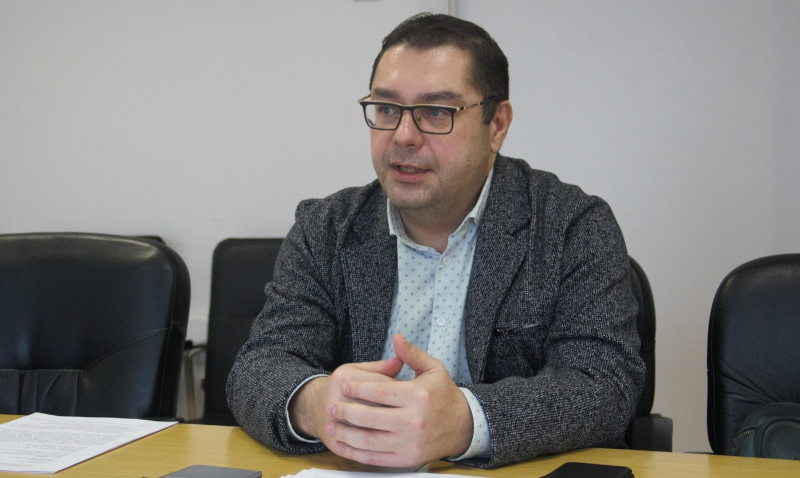
Photo: Vladimir Simindey
The head of research programs of the Historical Memory Foundation, Vladimir SIMINDEY (Russia), suggested that everyone involved in search and research activities take cameramen with them (or shoot themselves), because such content is really impressive and interesting even just as a video for users video platforms. It can be used for documentary studies and films.
Historian and public figure Viktor GUSCHIN raised an important historical question that we should not only glorify the military labor of soldiers, but also not forget about those who came up with ingenious strategic plans to squeeze the invaders out of Riga, thereby preserving the ancient architecture of the city to this day.
The forum was attended by an amateur historian Yuri SEDISHEV, who independently collected material and prepared three books about the Heroes of the Soviet Union during the Great Patriotic War.
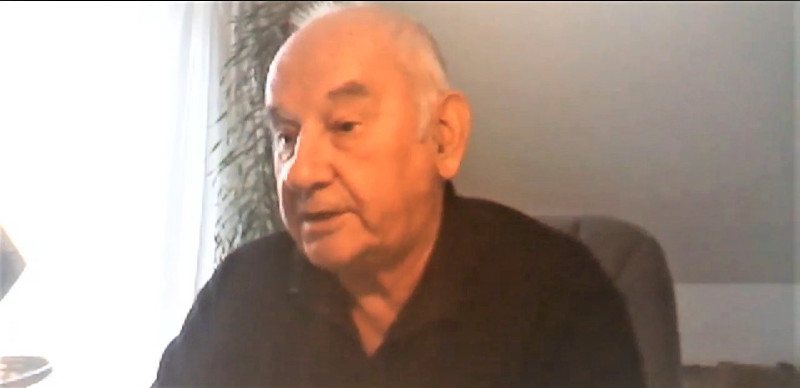
Photo: Yuri Sedyshev
“I was interested in how many people were awarded the titles of Heroes of the Soviet Union during the war years. And I established that during the war years 2119 aviators - Heroes of the Soviet Union, 8500 heroes-soldiers of the ground forces and 515 sailors - representatives of 100 nationalities - were awarded this title.
I became interested in how many Heroes of the Soviet Union are related to Latvia, and collected information - 320 people.
Veterans advised to publish a book, as no one had written about it before. The Jewish Society helped in the publication. After the first edition of the book, indignant calls began to arrive: “Why is my relative not in the book?”
So Yuri Sedyshev continued to collect information from direct descendants, asking for confirmation. More than 100 people of 19 nationalities gathered. As a result of this work, in 2018 the second edition of the book “The Perfect Name is Immortal” was published: in total, it contains about 420 Heroes of the Soviet Union related to Latvia.
It is not the first time that forum participants find like-minded people and allies in the matter of preserving historical memory. In the online chat during the forum session, participants send each other documentary evidence of one or another fact that they managed to find. During the 13th Session, a large number of materials were sent to the participants by local historian Alexander RZHAVIN.
Vlad Bogov said that he was ready to share a lot of visual materials about the 130th Order of Suvorov Latvian Rifle Corps.
Yuri Sedyshev asked the forum participants for information about the burial place of one of the commanders of the 201st Latvian Rifle Division, Heinrich Pfeil, since he could not get documentary evidence for his assumptions.
Yuri Sedyshev traced his path to 1954, and then the information is cut off. Heinrich Pfeil wrote a book of memoirs. Yuri Sedyshev has this book at his hands; he has prepared a typewritten text and is looking for a sponsor for publication.
And this is the idea of the second book. Hero of the Soviet Union Sergei Lyulin is known in Latvia, and even a street was named after him. He was a navigator, but he was not alone on the plane, there were the aircraft commander Grigory Nikolaev and the gunner-radio operator Manchenko. All three were presented to the titles of Heroes of the Soviet Union, but only Sergei Lyulin was awarded such a title, and the commander and shooter were given the Order of the Red Banner. Yuri Sedyshev talked with Colonel Nikolai Semenovich Ilichenko, who was the pilot-navigator of their regiment. He said that at the time of the ramming, which produced Lyulin's plane, Sergei Lyulin was already wounded and could not fly the plane. Accordingly, two of his comrades also performed a heroic deed. And Yuri Sedyshev would like to restore justice, if only by delivering this information today.
Yuri Sedyshev has a lot of thoughts and ideas about perpetuating the memory of the heroes of Latvia during the Second World War, three handwritten books with unique extracted and verified facts are ready, but there is no way to publish these books. The Eurasian Peoples' Assembly joins this work.
Andrey YAKOVLEV, a journalist from Riga (Latvia), who is currently under investigation for collaboration with the Russian media, presented a report on the history of the 130th Latvian Rifle Corps in modern Latvia. He summarized:
“If information about the 130th Rifle Corps appears in the Latvian media space, then the information is given with an emphasis on the fact that there were only 35 Latvians, there were many Russians and Jews, that is, they are not quite “ours”.
Andrey Yakovlev noted the importance of Vadim Gilis's idea that information should be captured and presented in short bright strokes.
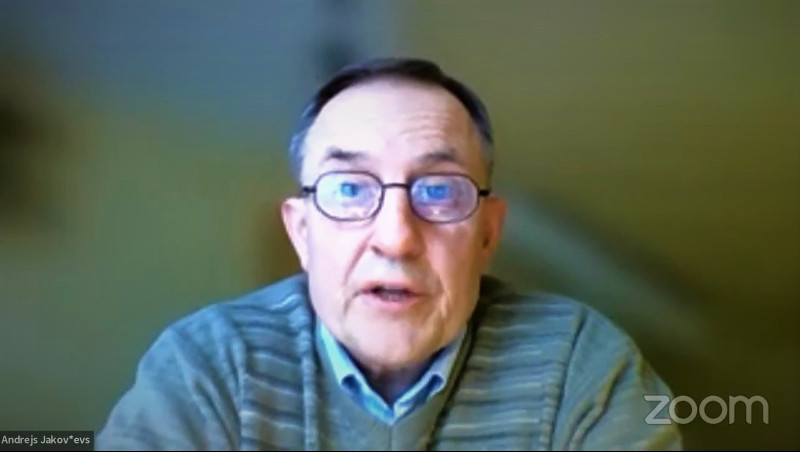
Photo: Andrey Yakovlev
A part of Andrey Tatarchuk's film “Latvian bayonets. Weapon of victory. The author spoke about the tasks set by the creators and about the facts he obtained about the Baltic offensive operation.
Doctor of Historical Sciences, Professor Laila AKHMETOVA from Kazakhstan, chronicler of the Panfilov division, noted that with each forum more and more new knowledge about military divisions appears, a new large group of like-minded people working in the same direction is formed.
Laila Akhmetova thanked Alexander Rzhavin for his serious scientific approach, for his local history publications, including those related to the Panfilov division. His photographs of gravestones from Latvia, sent in the chat of the broadcast of the 13th Session, she sent to her team.
Laila Akhmetova also noted that on the Internet people speculate with facts about the Panfilov division and say whatever they want:
“We are all descendants of the winners who were in that war together, and we all now experience the pain of the information war and the falsification of facts.”
Laila Akhmetova has been studying the history of the Panfilov division since her school years, in the mid-70s she met with the surviving Panfilovites. She invites everyone to the Association of Panfilov's Descendants:
“If you are not a descendant, be our friend. If we call all military units by name, then it will be clear how many people participated in the war, how many died. We can put it on the Internet, and everyone can find information about their ancestors.”
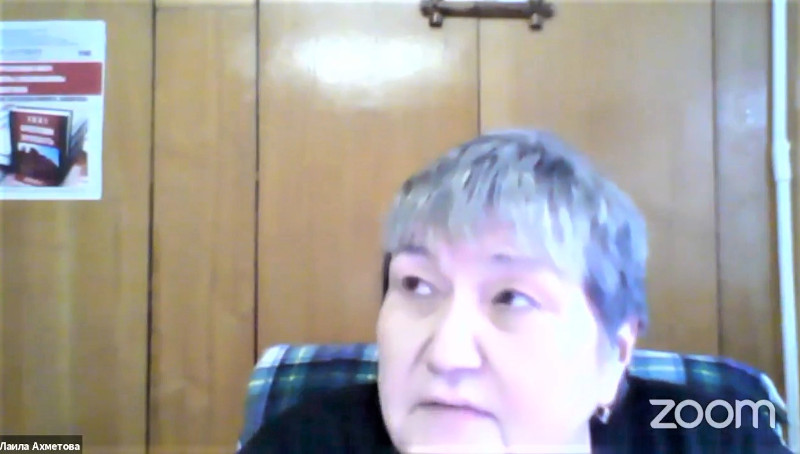
Photo: Laila Akhmetova
Alexander Rzhavin, a local historian from Riga (Latvia), drew attention to two points. We must not forget the history of 1941. Latvians immediately entered the war with the Nazis, but nothing is known about those military units. Latvians have something to be proud of - not only the 130th rifle corps, but also the battles of 1941, and joining the fight against fascism even before the start of World War II.
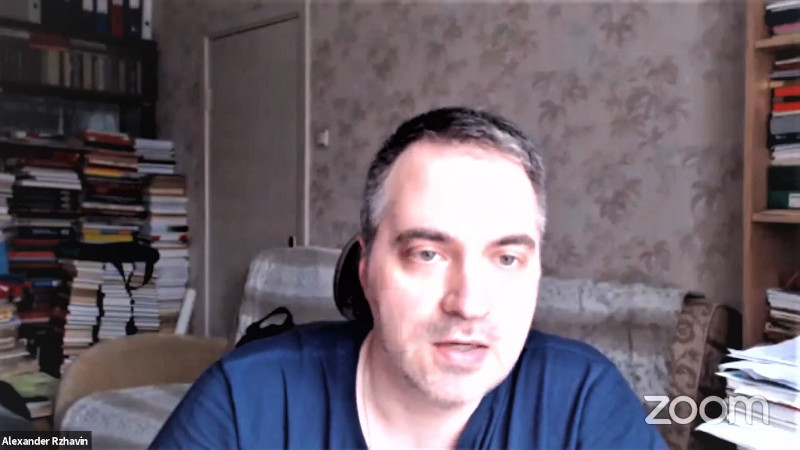
Photo: Alexander Rzhavin
“The second point is the design of memorials. In Latvia there is a memorial to the Latvian SS legion, and in terms of visual appearance and information support, this is an example of a memorial. At the memorial there is a museum where visitors will be told everything in detail, there are convenient parking lots. In contrast to it, there is a memorial to Soviet soldiers who died in battles with SS legionnaires, it does not look worthy...»
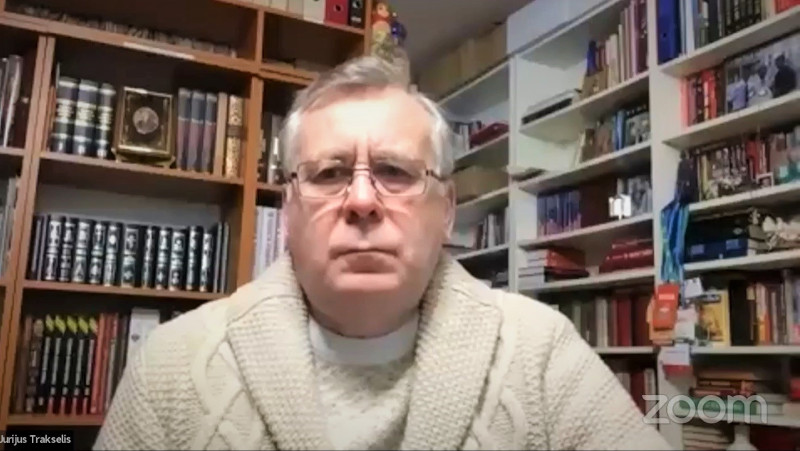
Photo: Jurijus Trakselis
Jurijus Trakselis summed up the meeting. As the main outcome of the 13th Session of the International Public Forum, he noted a serious message - the need to involve the youth of the whole world in the work to preserve the historical memory of the Second World War and the Great Patriotic War.


